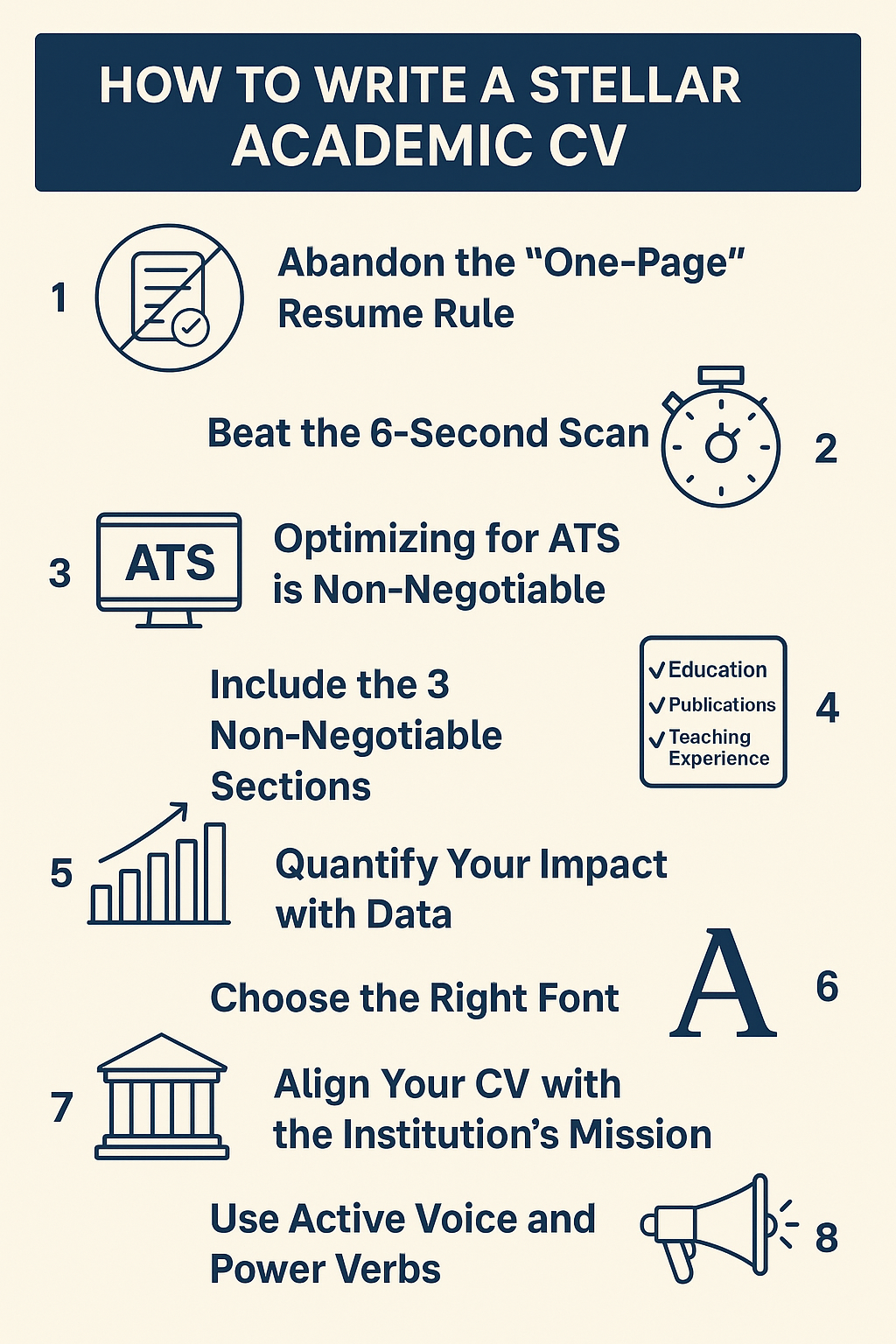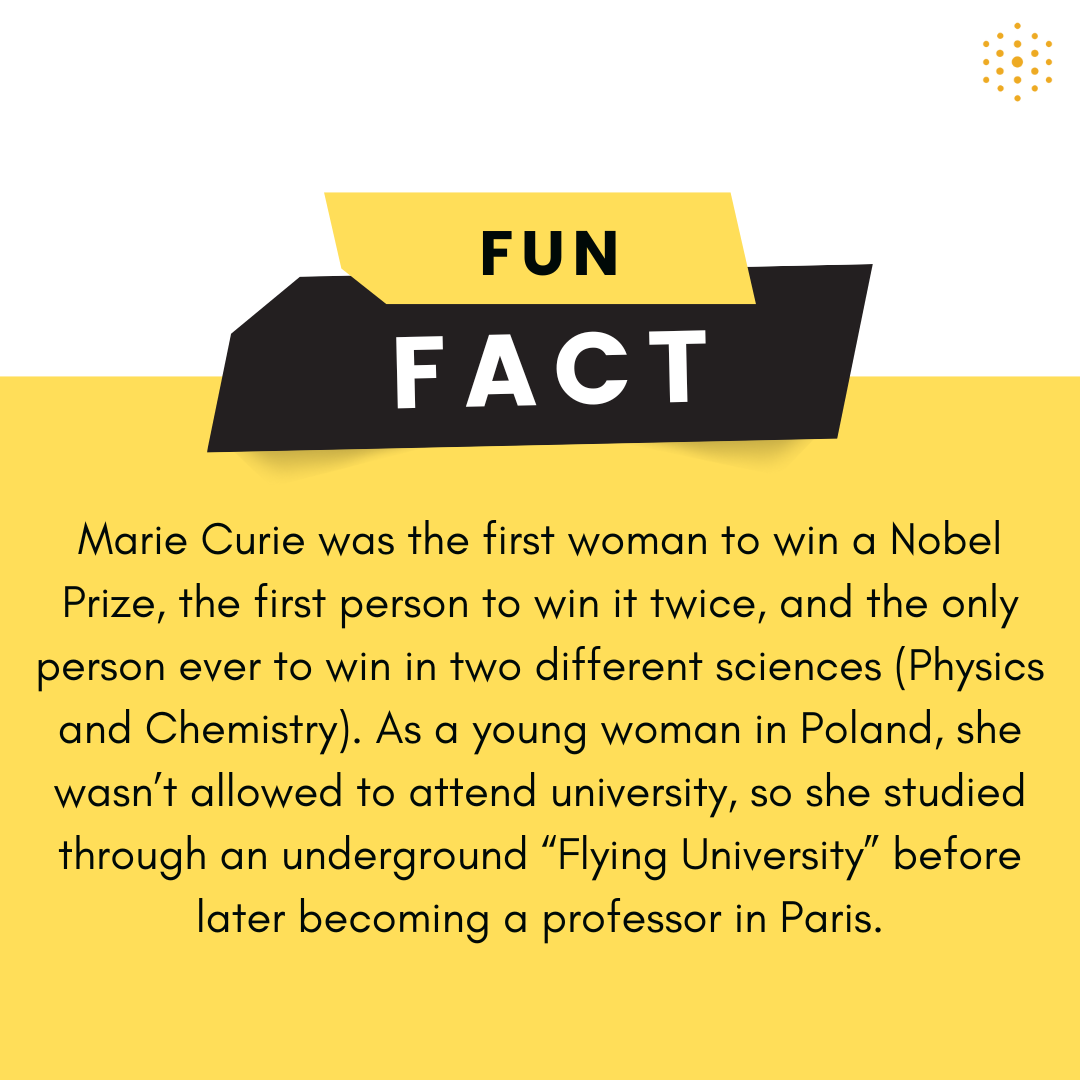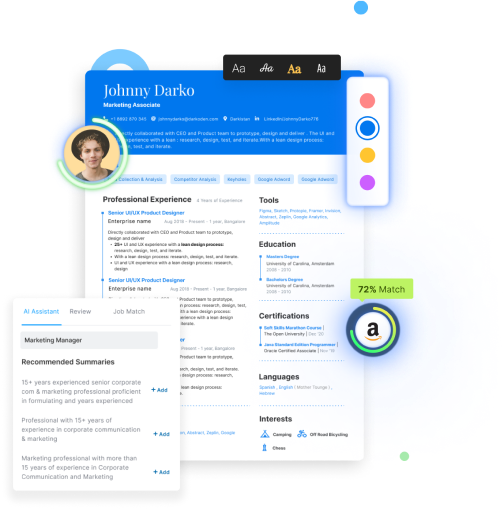What makes an academic CV stand out for tenure-track roles?
Academic CVs are judged on structure, substance, and strategy. Go beyond listing credentials — highlight quantifiable teaching impact, research outcomes, and institutional fit. Optimize for clarity, ATS-readability, and mission alignment. Your goal: transform your CV from a list of activities into a cohesive scholarly narrative that signals readiness for independent research and teaching.
The academic job market is notoriously competitive.
Fewer than 17% of newly minted PhDs in science, engineering, and health fields secure a tenure-track role within three years of graduating, according to a study published at PMC.
With hundreds of qualified PhDs vying for a single faculty position, your Curriculum Vitae (CV) isn’t just a document - it’s your entire scholarly identity on paper.
If you think a standard template will cut it, think again. You need a strategy that screams "future colleague," not just "graduate student."
Here is a detailed, actionable guide to crafting an academic CV that stands out, backed by the latest industry statistics and research.
1. Abandon the "One-Page" Resume Rule
One of the biggest misconceptions candidates have is conflating a resume with a CV.
While industry standards often dictate a strict one or two-page limit, an academic CV is a comprehensive history of your scholarly life.
According to the University of North Carolina, it is typical for an experienced researcher or professor to have a CV that is 5, 10, or even 20 pages long.
Do not artificially truncate your citations or teaching experience. Unlike a resume designed for quick scanning, your academic CV must be exhaustive.
2. Beat the 6-Second Scan (Yes, Even in Academia)
You might assume a search committee will read every word of your 10-page document. They won't, at least not initially.
Research indicates that recruiters and hiring managers spend an average of just 6 to 8 seconds scanning a document before deciding whether to shortlist it.
To survive this initial purge, your academic CV template must prioritize information hierarchy:
- Top Third of Page 1: Name, current affiliation, contact info, and research interests.
- Headings: Use bold, 14-16pt fonts for section headers like "Education," "Dissertation," and "Publications."

3. Optimizing for ATS is Non-Negotiable
Even universities use Applicant Tracking Systems (ATS) to manage the deluge of applications.
A staggering 75% of resumes and CVs are rejected by ATS before they ever reach a human eye due to poor formatting or lack of keywords.
Ensure your CV is machine-readable:
- File Format: Always submit as a PDF unless explicitly told otherwise.
- Keywords: Mirror the language of the job description. If they ask for "grant writing experience," use that exact phrase.
- Simplicity: Avoid columns and graphics. While a marketing resume might benefit from creative flair, an academic CV requires a clean, single-column layout.
4. The "Holy Trinity" of Sections
While you can include many sections, three are non-negotiable and must appear on the first or second page.
- Education: List in reverse chronological order. Include your dissertation title and advisor.
- Publications: This is your currency. Separate them into "Peer-Reviewed Articles," "Book Chapters," and "Manuscripts Under Review."
- Teaching Experience: Don't just list course numbers. Briefly describe your role (e.g., "Designed syllabus for...").
5. Quantify Your Impact with Data
Academia loves data, yet candidates often forget to include it in their own applications.
- Don't say: "Taught undergraduate students."
- Do say: "Lectured 2 sections of 'Intro to Biology' with 150+ students per semester and achieved a 4.8/5.0 student evaluation rating."
Quantifiable achievements are a trend across all sectors. For instance, data science resumes rely heavily on metrics, and your academic CV should be no different.
6. Choose the Right Font (Serif vs. Sans-Serif)
Your choice of font subtly communicates your professional brand. For academic CVs, readability and tradition often win.
- Safe Bets: Times New Roman, Garamond, or Cambria (Serif) imply tradition and authority.
- Modern Alternatives: Calibri or Arial (Sans-Serif) are clean and increasingly accepted.
- Avoid: Comic Sans or overly stylized fonts.
Experts at Adobe suggest that while sans-serif fonts like Helvetica are sleek, classic serif fonts like Garamond can help fit more text on a page without sacrificing readability.

7. Align Your CV with the Institution's Mission
The idea of a "universal" CV is a myth. Every institution has a different mission, and your CV must be strategically reordered to emphasize your fit.
- Research-Intensive (R1) Universities: Prioritize your Publications and Grants/Funding sections by moving them to the top of the CV, directly after your Education. Your goal is to prove research productivity and external funding potential.
- Teaching-Focused Colleges: Your Teaching Experience and Teaching Philosophy section should take priority. Detail your syllabus design, student-centered pedagogies, and mentoring outcomes.
- Industry/Research Centers (Post-Doc, Non-Faculty): Highlight specific technical skills, software proficiency (Python, R, specialized lab equipment), and project management experience.
8. Use Active Voice and Power Verbs
Passive voice obscures your agency. Your CV needs to use a strong, active voice to clearly communicate your contribution and impact, making your work immediately measurable and memorable.
- The Verb Swap: Replace weak verbs (e.g., "Responsible for," "Helped," "Assisted") with action verbs (e.g., "Pioneered," "Directed," "Authored," "Secured," "Mentored").
- Active Voice in Action: Instead of saying, "Responsibilities included supervising five graduate students," write "Mentored 5 graduate students through their thesis projects, leading to 3 conference presentations."
Final Thoughts
Your academic CV is a living document. Update it monthly.
By following these data-backed rules and avoiding common pitfalls, you will ensure your application survives the initial scan and lands on the "Must Interview" pile.
And if you’d like professional support in presenting your academic achievements with precision and clarity, Hiration can help you shape a CV that reflects your full scholarly impact and positions you competitively in a crowded market.
And beyond CVs, we can help elevate your entire application package - from LinkedIn positioning to focused cover letters and interview preparation - so every component strengthens your candidacy.
Here’s to presenting your work with the clarity and confidence it deserves!
Academic CV Writing — FAQ
How long should an academic CV be?
Unlike industry resumes, academic CVs can span 5–20 pages. Include every relevant publication, presentation, and teaching experience — completeness matters more than brevity.
Should academic CVs be optimized for ATS?
Yes. Many universities use Applicant Tracking Systems. Submit a clean, single-column PDF with consistent section headers and keywords mirroring the job description.
What are the three most important CV sections?
Education, Publications, and Teaching Experience. These sections should appear early and be formatted clearly to show research productivity and classroom impact.
How can I quantify my academic achievements?
Use data: student evaluation scores, number of mentees, grant funding amounts, or conference presentations. Numbers help committees gauge your real-world influence.
What fonts are best for academic CVs?
Stick to readable, professional fonts like Times New Roman, Garamond, or Cambria. Serif fonts lend credibility and conserve space for dense academic content.
How do I tailor my CV for different institutions?
Research-focused universities prioritize publications and funding; teaching colleges emphasize pedagogy and mentorship. Reorder sections accordingly to match the mission.
Why is active voice so important?
Active phrasing highlights agency — for example, “Secured $200K in NSF funding” conveys ownership and impact, unlike “Was responsible for grant writing.”
Can Hiration help create an academic CV?
Yes. Hiration’s AI platform helps scholars structure, polish, and tailor their CVs for academic and postdoc roles, ensuring clarity, precision, and alignment with institutional priorities.



